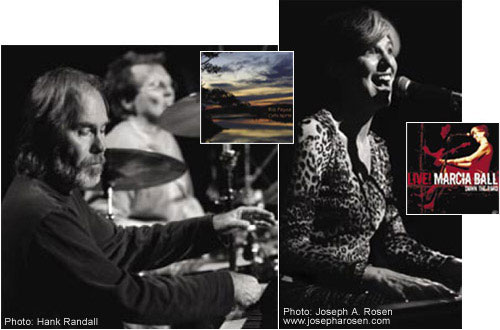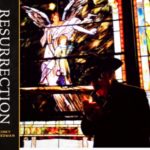
BILL PAYNE
Little Feat has made an impact in the way few bands have. Considered a cult band by some and a great American band by many, Little Feat first formed in Los Angeles in 1969 and still continues to record and tour to this day. At the helm of the band’s “rudderless ship” were former Frank Zappa/Mothers of Invention guitarist Lowell George and a then 20-year-old piano/keyboard whiz from Waco, Texas named Bill Payne.
Payne has been the musical heart (and in some instances the voice) of Little Feat for over 35 years, helping the band sustain long after Lowell George’s sudden death in 1979. Along the way, the Feat has released over a dozen classic albums for Warner Brothers, including Sailin’ Shoes (1972) and Dixie Chicken (1973). With an eclectic combination of blues, jazz, rock, and boogie-woogie, Payne has also penned such perennial Feat favorites as “Oh Atlanta,” “Time Loves a Hero” and “Day or Night.”
Aside from being the Feat’s most stable musical force, Payne has made over 350 guest appearances on records for such other notable luminaries as Jackson Browne, The Doobie Brothers, J.J. Cale and Emmylou Harris. In addition, Payne has spent recent years touring as a part of Jimmy Buffett’s backup band as well as playing keyboards on Buffett’s 2004 number one album License to Chill. The driving force for him, Payne says, has always been to have the ability to work and play music with some of the best people there are. He’s certainly been able to do that and continues to do it.
Payne released his first solo album, the all-instrumental Cielo Norte, in February of 2005. The album is the first release off the Feat’s own Hot Tomato Records and is a enormously personal, fun and interesting effort from a very interesting artist.
MARCIA BALL
In terms of the blues, Marcia Ball is in a league of her own. The Louisiana native, who began taking piano lessons at the age of five, has been performing and making her own kind of rollicking music for nearly 30 years.
Born in 1949, Ball discovered the blues, particularly Irma Thomas, at age 13. In time Ball fell in love with the piano melodies of New Orleans natives Fats Domino and Professor Longhair. After relocating to San Francisco in 1971, she joined up with a band called Freda and the Firedogs and began to develop her piano talents. By 1974, the band had called it quits and Ball signed to Capitol Records, releasing her debut album Circuit Queen in 1978.
After signing to Rounder Records, Ball released six albums between 1984 and 1998 (Soulful Dress to Sing It!), all of which garnered immense critical praise. Sing It! would in time be nominated for a Grammy. In addition, Ball was inducted into the Austin Music Hall of Fame in 1990.
Ball switched labels and released Presumed Innocent on Alligator Records in 2001. The album received glowing reviews and led to a variety of television appearances.
Ball’s latest Alligator album, Live! Down The Road was released in April 2005 to rave reviews. Since then, Ball has hit the road and will be on a busy touring schedule through the end of 2007, including The Cambridge Folk Festival in England.. She has recently been making appearances with large orchestras, including the Cincinnati Symphony and the Jacksonville (Florida) Symphony Orchestra. In addition, Marcia Ball was named the Pinetop Perkins Piano Player of the Year at the 2006 Blues Foundation Awards. E
![]()
Elmore: What are you listening to right now?
Bill Payne: Cholino Sanchez, and Alicia de Larrocha, a Spanish pianist playing Mozart. Glenn Gould, and Howlin’ Wolf.
Marcia Ball: Ray Charles, both early and late. The Neville Brothers, especially for rhythmic inspiration. Fire on the Bayou, Otis Spann’s Walking the Blues, and several on the pile. Robert Lockwood, Jr.
EM: What was the first record you ever bought?
BP: “Big Boy Pete” by the Olympics. Maybe “The Ghost of Maloo Dorsey”
MB: Records that I first had my brother had. Ray Charles, Clifton Chenier, Dinah Washington; I was seriously influenced by her singing.
EM: Where do you buy your music?
BP: El Ritmo, a Spanish store in L.A., and at Borders.
MB: Waterloo Records in Austin.
EM: What’s your favorite album of all time?
BP: Don’t have one.
MB: The Band, by The Band, Dr. John’s Goin’ Back To New Orleans and Doug Sahm’s Jukebox Music.
EM: What was the first instrument you played?
BP: Piano. I played guitar, but upside down and backwards, which makes sense because like piano, the rhythm is in the left hand.
MB: Piano. I have accordions and an acoustic guitar.
EM: What brought you to the instrument you now play?
BP: My mother taught me piano before I was five. And the little girl across the street was taking piano lessons.
MB: Family. My grandmother and aunt played piano, and there was a piano in the house, always.
EM: What musician influenced you most?
BP: For rock ‘n’ roll, Keith Richards, Little Richard, and Elvis’s piano player on “HoundDog.” But it was really my piano teacher from five to 15, Ruth Newman, who allowed me to play by ear as well as reading music.
MB: Cyril Neville and Allan Toussaint
EM: Who would you like to write with that you haven’t?
BP: Well, writing for me is not like playing. I guess I’d love to write with Mac McAnally some time perhaps. And Buffett. I think on other levels . . . it’s hard to say. Like a lot of people treat writing as if we have to sit down and write today. We’re going to do this every day. I’m not that kind of guy. (interruption for phone call) Normally people . . . I’ve written with John Lennon and my thing is I’d rather play music with them.
MB: Cyril Neville.
EM: What was the song or event that made you realize you wanted to be in music?
BP: My first paying gig was at the Eagle’s Hall in Santa Maria, California. It was $5 and all the beer you could drink, and I was sixteen years old. Maybe fifteen. By that time I held on to it like a life raft. My music teacher, Ruth Newman, said, “Hey, there are a couple of boys who play bass and guitar and they want to know if you want to play some piano with them.” That kind of thing. Two to three months later, she died of a heart attack
MB: I always knew it was the way to get out of housework and gather attention. I got in a band in college at LSU, and pretty much from the first, I thought “If I can do this, I just keep doing it.”
EM: Who would you like in your rock and roll heaven band?
BP: Certainly Lowell George. Keith. Drums . . . that’s a good question. Levon Helm. I love Levon. Of course I’d have Hendrix. Sonny Landreth would be another guy I’d love to introduce to Lowell. The ones who are serious players . . . say, Louis Armstrong on trumpet. I would have loved to have worked with Frank Zappa, for example. I’ll think of 20 people that I’d love in a band. Put Frank in there for sure, just to drive everybody crazy. Put him and Miles Davis together. They could drive each other crazy.
MB: Earl Palmer on drums, George Porter, Jr. on bass Albert Collins on guitar, David “Fathead” Newman on sax. I’m kind of pulling some of Ray Charles’ band here. I’d like Ray to be my bandleader and musical director, and he could play keyboards. I’d play keyboards too, we’d have two in my Heaven band. That’s a good start
EM: What’s your desert island CD?
BP: I would probably pick something that was somewhat relaxing I suppose. So maybe some Mozart sonatas by Alicia De La Rocha.
MB: Professor Longhair’s “New Orleans Piano.” It’s a re-issue.






Be the first to comment!